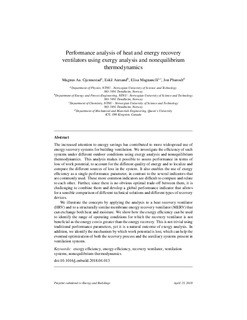| dc.contributor.author | Gjennestad, Magnus Aashammer | |
| dc.contributor.author | Aursand, Eskil | |
| dc.contributor.author | Magnanelli, Elisa | |
| dc.contributor.author | Pharoah, John George | |
| dc.date.accessioned | 2018-04-26T06:28:57Z | |
| dc.date.available | 2018-04-26T06:28:57Z | |
| dc.date.created | 2018-04-25T15:17:00Z | |
| dc.date.issued | 2018 | |
| dc.identifier.issn | 0378-7788 | |
| dc.identifier.uri | http://hdl.handle.net/11250/2496018 | |
| dc.description.abstract | The increased attention to energy savings has contributed to more widespread use of energy recovery systems for building ventilation. We investigate the efficiency of such systems under different outdoor conditions using exergy analysis and nonequilibrium thermodynamics. This analysis makes it possible to assess performance in terms of loss of work potential, to account for the different quality of energy and to localize and compare the different sources of loss in the system. It also enables the use of exergy efficiency as a single performance parameter, in contrast to the several indicators that are commonly used. These more common indicators are difficult to compare and relate to each other. Further, since there is no obvious optimal trade-off between them, it is challenging to combine them and develop a global performance indicator that allows for a sensible comparison of different technical solutions and different types of recovery devices.
We illustrate the concepts by applying the analysis to a heat recovery ventilator (HRV) and to a structurally similar membrane energy recovery ventilator (MERV) that can exchange both heat and moisture. We show how the exergy efficiency can be used to identify the range of operating conditions for which the recovery ventilator is not beneficial as the energy cost is greater than the energy recovery. This is not trivial using traditional performance parameters, yet it is a natural outcome of exergy analysis. In addition, we identify the mechanism by which work potential is lost, which can help the eventual optimization of both the recovery process and the auxiliary systems present in ventilation systems. | nb_NO |
| dc.language.iso | eng | nb_NO |
| dc.publisher | Elsevier | nb_NO |
| dc.rights | Attribution-NonCommercial-NoDerivatives 4.0 Internasjonal | * |
| dc.rights.uri | http://creativecommons.org/licenses/by-nc-nd/4.0/deed.no | * |
| dc.title | Performance analysis of heat and energy recovery ventilators using exergy analysis and nonequilibrium thermodynamics | nb_NO |
| dc.type | Journal article | nb_NO |
| dc.type | Peer reviewed | nb_NO |
| dc.description.version | acceptedVersion | nb_NO |
| dc.source.journal | Energy and Buildings | nb_NO |
| dc.identifier.doi | 10.1016/j.enbuild.2018.04.013 | |
| dc.identifier.cristin | 1581631 | |
| dc.description.localcode | © 2018. This is the authors’ accepted and refereed manuscript to the article. Locked until 17.4.2020 due to copyright restrictions. This manuscript version is made available under the CC-BY-NC-ND 4.0 license http://creativecommons.org/licenses/by-nc-nd/4.0/ | nb_NO |
| cristin.unitcode | 194,66,20,0 | |
| cristin.unitcode | 194,66,25,0 | |
| cristin.unitcode | 194,64,25,0 | |
| cristin.unitname | Institutt for fysikk | |
| cristin.unitname | Institutt for kjemi | |
| cristin.unitname | Institutt for energi- og prosessteknikk | |
| cristin.ispublished | false | |
| cristin.fulltext | postprint | |
| cristin.qualitycode | 2 | |

